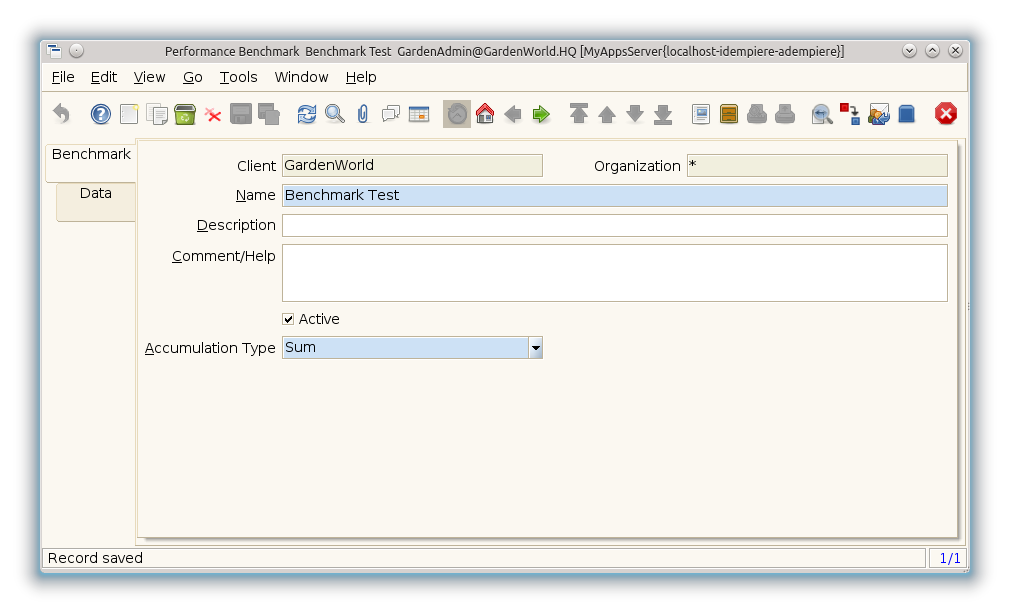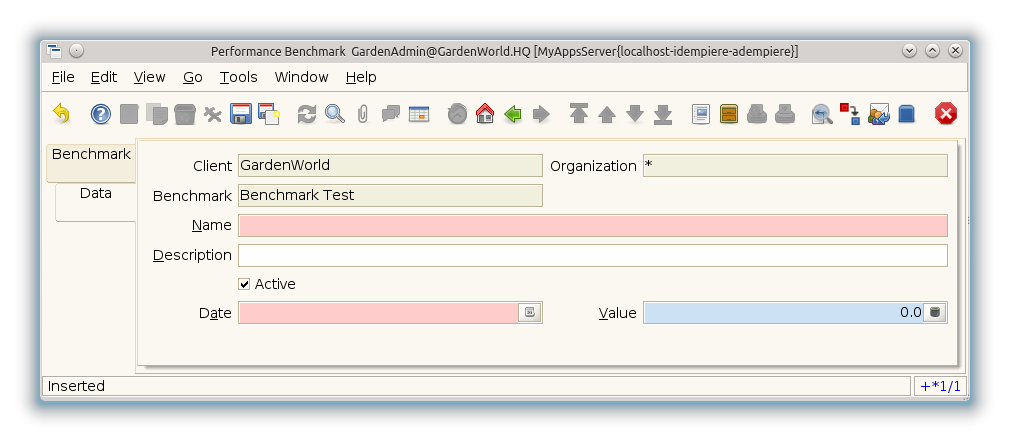Performance Benchmark (Window ID-365)
Window: Performance Benchmark
Description: Performance Benchmark
Help: Data Series to compare internal performance with (e.g. stock price, ...)
Tab: Benchmark
Description: Performance Benchmark
Help: Data Series to compare internal performance with (e.g. stock price, ...)
| Name | Description | Help | Technical Data |
|---|---|---|---|
| Tenant | Tenant for this installation. | A Tenant is a company or a legal entity. You cannot share data between Tenants. | PA_Benchmark.AD_Client_ID numeric(10) Table Direct |
| Organization | Organizational entity within tenant | An organization is a unit of your tenant or legal entity - examples are store, department. You can share data between organizations. | PA_Benchmark.AD_Org_ID numeric(10) Table Direct |
| Name | Alphanumeric identifier of the entity | The name of an entity (record) is used as an default search option in addition to the search key. The name is up to 60 characters in length. | PA_Benchmark.Name character varying(60) String |
| Description | Optional short description of the record | A description is limited to 255 characters. | PA_Benchmark.Description character varying(255) String |
| Comment/Help | Comment or Hint | The Help field contains a hint, comment or help about the use of this item. | PA_Benchmark.Help character varying(2000) Text |
| Active | The record is active in the system | There are two methods of making records unavailable in the system: One is to delete the record, the other is to de-activate the record. A de-activated record is not available for selection, but available for reports.
There are two reasons for de-activating and not deleting records: (1) The system requires the record for audit purposes. (2) The record is referenced by other records. E.g., you cannot delete a Business Partner, if there are invoices for this partner record existing. You de-activate the Business Partner and prevent that this record is used for future entries. |
PA_Benchmark.IsActive character(1) Yes-No |
| Accumulation Type | How to accumulate data on time axis | Sum adds the data points (e.g. stock volume) - Average is appropriate for e.g. Stock Price | PA_Benchmark.AccumulationType character(1) List |
Tab: Data
Description: Performance Benchmark Data Point
Help: Data Series Point to compare internal performance with (e.g. stock price, ...)
| Name | Description | Help | Technical Data |
|---|---|---|---|
| Tenant | Tenant for this installation. | A Tenant is a company or a legal entity. You cannot share data between Tenants. | PA_BenchmarkData.AD_Client_ID numeric(10) Table Direct |
| Organization | Organizational entity within tenant | An organization is a unit of your tenant or legal entity - examples are store, department. You can share data between organizations. | PA_BenchmarkData.AD_Org_ID numeric(10) Table Direct |
| Benchmark | Performance Benchmark | Data Series to compare internal performance with (e.g. stock price, ...) | PA_BenchmarkData.PA_Benchmark_ID numeric(10) Table Direct |
| Name | Alphanumeric identifier of the entity | The name of an entity (record) is used as an default search option in addition to the search key. The name is up to 60 characters in length. | PA_BenchmarkData.Name character varying(60) String |
| Description | Optional short description of the record | A description is limited to 255 characters. | PA_BenchmarkData.Description character varying(255) String |
| Active | The record is active in the system | There are two methods of making records unavailable in the system: One is to delete the record, the other is to de-activate the record. A de-activated record is not available for selection, but available for reports.
There are two reasons for de-activating and not deleting records: (1) The system requires the record for audit purposes. (2) The record is referenced by other records. E.g., you cannot delete a Business Partner, if there are invoices for this partner record existing. You de-activate the Business Partner and prevent that this record is used for future entries. |
PA_BenchmarkData.IsActive character(1) Yes-No |
| Date | Benchmark Date | Date of the Benchmark Data Point | PA_BenchmarkData.BenchmarkDate timestamp without time zone Date+Time |
| Value | Benchmark Value | Value of the Benchmark Data Point | PA_BenchmarkData.BenchmarkValue numeric Number |


